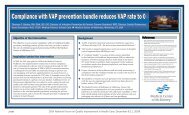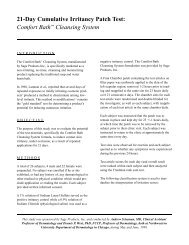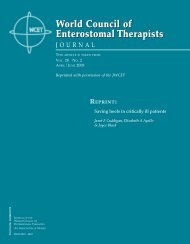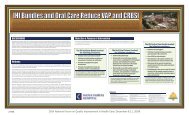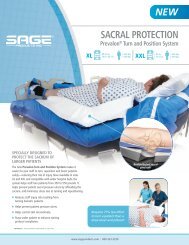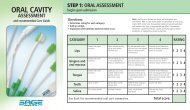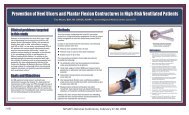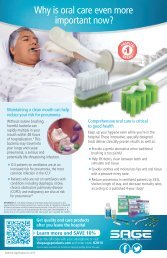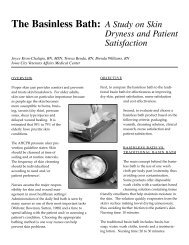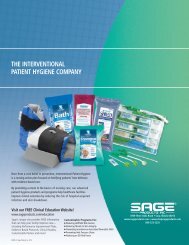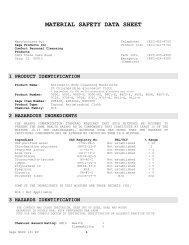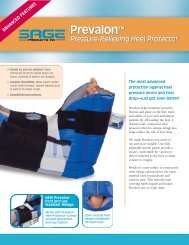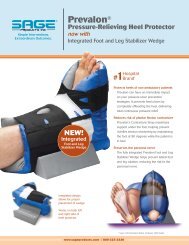Aspiration and Aspiration Pneumonia Prevention California Pacific ...
Aspiration and Aspiration Pneumonia Prevention California Pacific ...
Aspiration and Aspiration Pneumonia Prevention California Pacific ...
Create successful ePaper yourself
Turn your PDF publications into a flip-book with our unique Google optimized e-Paper software.
<strong>Aspiration</strong> <strong>and</strong> <strong>Aspiration</strong> <strong>Pneumonia</strong><br />
<strong>Prevention</strong><br />
at<br />
<strong>California</strong> <strong>Pacific</strong> Medical Center<br />
The Journey<br />
Bing Tschai, RN, MSN<br />
Pam Marshall, RN<br />
10/26/2010<br />
1
Goals<br />
1. Review <strong>Aspiration</strong> <strong>and</strong> <strong>Aspiration</strong><br />
<strong>Pneumonia</strong> <strong>Prevention</strong> improvement<br />
processes implemented at CPMC<br />
2. Discuss lessons learned<br />
2
<strong>Aspiration</strong><br />
Definitions<br />
– the inhalation of oropharyngeal or gastric<br />
contents into the larynx <strong>and</strong> lower respiratory<br />
track (Irwin, 1999).<br />
<strong>Aspiration</strong> <strong>Pneumonia</strong><br />
– an infectious process caused by the inhalation<br />
of oropharyngeal secretions (food, liquid, or<br />
gastric contents) that are colonized by<br />
pathogenic bacteria (Marik, 2001).<br />
3
Incidence of <strong>Aspiration</strong>s<br />
• Between 50% to 75% of patients receiving<br />
mechanical ventilation<br />
• Up to 70% of patients with altered levels of<br />
consciousness<br />
• Up to 45% of normal patients during sleep<br />
• Up to 40% of patients receiving enteral feedings<br />
McClave et al. (2002)<br />
4
CPMC <strong>Aspiration</strong> & <strong>Aspiration</strong><br />
<strong>Pneumonia</strong> <strong>Prevention</strong><br />
• The Set-up<br />
Situation<br />
Patient story<br />
• The Data<br />
5
CPMC<br />
<strong>Aspiration</strong> Not Present On Admission<br />
2005 N=127<br />
Discharge Disposition<br />
EXPIRED<br />
DISCH TO SNF<br />
HOME OR SELF CARE<br />
HOME WITH HOME HEALTH SERVICES<br />
DISCH/TRANS TO OUTSIDE INST<br />
DISCH TO ANOTHER HOSP<br />
AGAINST MEDICAL ADVICE<br />
Gr<strong>and</strong> Total<br />
Total<br />
40<br />
40<br />
18<br />
15<br />
8<br />
5<br />
1<br />
127<br />
31%<br />
6
Stroke<br />
Card<br />
Liver<br />
Oncology<br />
Abd<br />
<strong>Aspiration</strong> Mortality <strong>and</strong> Services<br />
2005 N=40<br />
Neuro/Spine<br />
Sepsis<br />
Renal<br />
Ortho<br />
7<br />
6<br />
6<br />
6<br />
5<br />
4<br />
3<br />
2<br />
1<br />
10%<br />
13%<br />
8%<br />
5%<br />
3%<br />
17%<br />
15%<br />
15%<br />
stroke Card Liver<br />
Oncology Abd Neuro/Spine<br />
Sepsis Renal Ortho<br />
14%<br />
7
CPMC <strong>Aspiration</strong> & <strong>Aspiration</strong><br />
<strong>Pneumonia</strong> <strong>Prevention</strong><br />
• Multidisciplinary Team Approach (6/2006)<br />
– Physicians <strong>and</strong> Nurse Practitioners<br />
– Registered Nurses (RN)<br />
– Speech Language Pathologists (SLP)<br />
– Patient Care Assistants (PCA)<br />
– Clinical Dietitians <strong>and</strong> Nutrition Services<br />
– Respiratory Therapists (RT)<br />
– Quality Coordinator<br />
8
Evidence Based Practices<br />
• Guidelines for Preventing Health-Care<br />
Associated <strong>Pneumonia</strong>, 2003 (Tablan et al &<br />
Healthcare Infection Control Practices<br />
Advisory Committee, Centers for Disease<br />
Control <strong>and</strong> <strong>Prevention</strong> (CDC), 2004)<br />
• Guidelines for the Management of Adults<br />
with Hospital-acquired, Ventilatorassociated,<br />
<strong>and</strong> Healthcare-associated<br />
<strong>Pneumonia</strong> (American Thoracic Society,<br />
2005)<br />
9
<strong>Prevention</strong> of <strong>Aspiration</strong> <strong>Pneumonia</strong><br />
Recommendation Highlights<br />
• Increase HOB 30°-45°<br />
• Frequent <strong>and</strong> Thorough Oral Hygiene<br />
• Routinely verify appropriate placement of<br />
feeding tubes<br />
– Tablan et al., CDC. (2004)<br />
• Implement Dysphagia screening program<br />
– Hinchey et al., Stroke (2005)<br />
• Implement Oral-Hygiene program<br />
– Bowman et al., Critical Care Nursing Quarterly (2005)<br />
10
<strong>Aspiration</strong> & <strong>Aspiration</strong> <strong>Pneumonia</strong><br />
Bundle Approach<br />
6 Bundle Elements:<br />
1. Assess ALL patients for aspiration risk<br />
2. Bedside Swallow Screening<br />
3. Suction set-up at bed-side<br />
4. HOB at 30 degrees<br />
5. Frequent Oral Care<br />
6. Safe care delivery of 1:1 supervise/assist meals<br />
11
RN identifies<br />
patients at<br />
risk<br />
HOB is elevated at 30º<br />
at all times . . .<br />
. . . <strong>and</strong> at 60º–90º for meals<br />
No food, liquid, or medications<br />
until RN does Swallow<br />
Screening or Dysphagia<br />
Evaluation done by Speech<br />
Frequent mouth<br />
care<br />
Suction is set up at<br />
bedside & ready<br />
Assist or supervise 1:1<br />
precaution patients at<br />
meal time<br />
Feed me..<br />
12<br />
CPMC Quality 05 2008
1:1 Assist or Supervision Meal Tray<br />
Teal meal tray stays in food cart, <strong>and</strong> not to be placed in patient’s room<br />
13
CPMC <strong>Aspiration</strong> & <strong>Aspiration</strong><br />
<strong>Pneumonia</strong> <strong>Prevention</strong><br />
Documents:<br />
• <strong>Aspiration</strong> & <strong>Aspiration</strong> <strong>Pneumonia</strong><br />
<strong>Prevention</strong> Protocol<br />
• Oral Care Protocol<br />
• Nursing Bedside Swallow Screening Tool<br />
14
CPMC <strong>Aspiration</strong> & <strong>Aspiration</strong><br />
<strong>Pneumonia</strong> <strong>Prevention</strong><br />
Equipments:<br />
• Suction Set-ups at the Bedside<br />
• Suction tooth brushes <strong>and</strong> swabs<br />
• Teal color meal trays<br />
15
CPMC <strong>Aspiration</strong> & <strong>Aspiration</strong><br />
<strong>Pneumonia</strong> <strong>Prevention</strong><br />
PCIS Order Sets / Documentation & Communication<br />
Tools:<br />
• Incorporate asp risk assessment in patient flow sheet <strong>and</strong> Nursing<br />
Admission Data Base<br />
• Asp prevention bundle elements are printed on the Patient Shift Care<br />
Summary once a Nurse identifies patient on PCIS as at risk for<br />
aspiration.<br />
• PCIS documentation of Nursing bedside swallow screening.<br />
• St<strong>and</strong>ardized Speech Pathology Therapist orders to clearly identify<br />
patients who require 1:1 Assist or 1:1 Supervision at meal time. (so<br />
dietary knows who gets a Teal Tray)<br />
16
CPMC <strong>Aspiration</strong> & <strong>Aspiration</strong><br />
<strong>Pneumonia</strong> <strong>Prevention</strong><br />
PCIS Order Sets / Documentation & Communication<br />
Tool:<br />
• Warning label placed next to the Teal meal tray<br />
• On dem<strong>and</strong> print out of unit specific 1:1 Assist or 1:1<br />
Supervision patient list<br />
• Physician notification of aspiration risk when diet<br />
order is placed<br />
• <strong>Aspiration</strong> Precaution Sign at Head of Bed<br />
17
CPMC <strong>Aspiration</strong> & <strong>Aspiration</strong><br />
<strong>Pneumonia</strong> <strong>Prevention</strong><br />
Education Tools:<br />
• ‘Bundle’ poster<br />
• Oral Care Table<br />
• Bedside Swallow Screening Tool<br />
• Risk Assessment Flow Chart<br />
• Teaching modules (long <strong>and</strong> short):<br />
– Nursing Bedside Swallow Screening<br />
–Oral Care<br />
18
CPMC <strong>Aspiration</strong> & <strong>Aspiration</strong><br />
<strong>Pneumonia</strong> <strong>Prevention</strong><br />
General roll out stretegies:<br />
• 1st week of roll out month: In-service on Bundle concept<br />
esp. Teal meal tray delivery for 1:1 assist <strong>and</strong> Supervise<br />
patients<br />
• 2nd week: Teal meal tray roll out<br />
• 3rd week: Oral Care in-service, includes family education<br />
• 4th week : Nursing Bed side Swallow Screening inservice,<br />
includes family education<br />
• Education with RNs at new hire orientation & PCAs at<br />
skill days<br />
19
CPMC <strong>Aspiration</strong> & <strong>Aspiration</strong><br />
<strong>Pneumonia</strong> <strong>Prevention</strong><br />
General roll out stretegies:<br />
It has taken a few Villages<br />
• Stroke Team built the foundation<br />
• PACE Council reinforced education & fine tuned the<br />
<strong>Aspiration</strong> <strong>Prevention</strong> Protocol<br />
• Speech Pathology Therapist provided expertise with<br />
swallow screening techniques<br />
• Nutritional Services coordinates assembling <strong>and</strong> delivery<br />
of Teal<br />
• Quality orchestrates the plan <strong>and</strong> conducts inservices<br />
20
CPMC <strong>Aspiration</strong> & <strong>Aspiration</strong><br />
<strong>Pneumonia</strong> <strong>Prevention</strong><br />
Measurement:<br />
Administrative data to capture Patients who<br />
have a discharge diagnosis of <strong>Aspiration</strong><br />
<strong>Pneumonia</strong> which is not present on<br />
admission (NPOA):<br />
• Incident ; count <strong>and</strong> rate<br />
• Mortality; count <strong>and</strong> rate<br />
21
CPMC <strong>Aspiration</strong> & <strong>Aspiration</strong><br />
<strong>Pneumonia</strong> <strong>Prevention</strong><br />
Counter Balance<br />
• Increase Referrals to Speech Pathology<br />
• Potential of meal trays staying in cart longer<br />
• De-emphasis of Speech Pathology services other than<br />
evaluation of dysphagia<br />
• Kept NPO for extended periods of time while awaiting<br />
more formal consults.<br />
22
CPMC <strong>Aspiration</strong> & <strong>Aspiration</strong><br />
<strong>Pneumonia</strong> <strong>Prevention</strong><br />
Implementation Status<br />
• Completed 17/22 (77%) targeted areas in<br />
3 Campuses<br />
• Remaining areas are 2 ICU, 1 ICU Step<br />
Down, <strong>and</strong> 2 Med surg units<br />
23
CPMC <strong>Aspiration</strong> & <strong>Aspiration</strong><br />
Data Slide<br />
<strong>Pneumonia</strong> <strong>Prevention</strong><br />
24
CPMC <strong>Aspiration</strong> & <strong>Aspiration</strong><br />
<strong>Pneumonia</strong> <strong>Prevention</strong><br />
Lessons learned: the good..<br />
• Overwhelming Staff endorsement of concept at all levels<br />
•<br />
• Different color meal tray gains most support<br />
• Processes by which patient’s <strong>Aspiration</strong> Risk Status is<br />
communicated to various discipline has to be part of the<br />
workflow<br />
• Availability of electronic order entry <strong>and</strong> ancillary (nursing,<br />
speech, dietitian) notes entry make our plan of<br />
intervention possible<br />
25
CPMC <strong>Aspiration</strong> & <strong>Aspiration</strong><br />
<strong>Pneumonia</strong> <strong>Prevention</strong><br />
Lessons learned: the challenges…<br />
Difficulties in using mortality as primary end point to<br />
measure aspiration prevention effort.<br />
Lack of a systemic way to obtain accurate data in<br />
the measurement of When, Where, <strong>and</strong> How an<br />
aspiration event occurred<br />
26
CPMC <strong>Aspiration</strong> & <strong>Aspiration</strong><br />
<strong>Pneumonia</strong> <strong>Prevention</strong><br />
Next Steps:<br />
• Complete roll out of bundle to remaining units<br />
• Data drill down <strong>and</strong> feed back to the staff<br />
• Reconvene PI team to discuss alternate<br />
measurement indicators<br />
• Project presentation to Population Committees<br />
<strong>and</strong> Administration<br />
27
CPMC <strong>Aspiration</strong> & <strong>Aspiration</strong><br />
<strong>Pneumonia</strong> <strong>Prevention</strong><br />
TOOLS<br />
28
Oral Care Reference Table<br />
Patient Types<br />
Self Care,<br />
Non-intubated,<br />
Dependent Care, Nonintubated,<br />
Critical Care,<br />
Non-intubated<br />
Intubated,<br />
on Mechanical<br />
Ventilation<br />
Tooth Brushing Mouthwash/Mouthrinse Mouth<br />
How Often With What How Often With What<br />
Moisturizer<br />
Daily Soft Bristle<br />
Tooth Brush &<br />
Toothpaste<br />
AM<br />
&<br />
PM<br />
AM<br />
&<br />
PM<br />
AM<br />
&<br />
PM<br />
Suction Tooth<br />
Brush &<br />
Antiseptic<br />
Mouthwash<br />
Suction Tooth<br />
Brush &<br />
Antiseptic<br />
Mouthwash<br />
Suction Tooth<br />
Brush &<br />
Antiseptic<br />
Mouthwash<br />
PRN Antiseptic<br />
Mouthwash<br />
Q 4<br />
Hours<br />
Q 2<br />
Hours<br />
Q 2<br />
Hours<br />
Suction Swab<br />
with<br />
Antiseptic<br />
Mouthwash<br />
Suction Swab<br />
with<br />
Antiseptic<br />
Mouthwash<br />
Suction Swab<br />
with<br />
Antiseptic<br />
Mouthwash<br />
Helpful H ints:<br />
1. Oral C are involves the teeth, gum <strong>and</strong> oral m ucosa, tongue, upper palate, saliva <strong>and</strong> lips<br />
2. Position P atient’s head to the side or place in semi-fowler’s position as tolerated<br />
Q 4 hours<br />
(Following<br />
Mouth Wash)<br />
Q 2 hours<br />
(Following<br />
Mouth Wash)<br />
Q 2 hours<br />
(Following<br />
Mouth Wash)<br />
Denture Care<br />
Daily removal<br />
& Cleaning<br />
Daily removal<br />
& Brushing<br />
with<br />
toothpaste<br />
Daily removal<br />
& Brushing<br />
with<br />
toothpaste<br />
Removal of<br />
Subglottal<br />
Secretions<br />
AM & PM<br />
Prior to ET Tube<br />
repositioning<br />
Prior to deflation<br />
of ET cuff<br />
3. Suction Toothbrush <strong>and</strong> Suction Swab: use w ith Antiseptic M outh W ash; apply suction throughout the tooth brushing session, to prevent oral care<br />
products <strong>and</strong> secretions from going dow n the patient’s throat<br />
4. Brush with gentle pressure while m oving in short horizontal or circular strokes<br />
5. Place swab perpendicular to the gum line <strong>and</strong> apply gentle m echanical action for one to two m inutes; rotate swab as you remove it from the patient’s<br />
mouth<br />
6. Apply mouth m oisturizer inside entire oral cavity <strong>and</strong> on lips<br />
31
Posting at Head of Bed<br />
32
1:1 Assist or Supervision Meal Tray &<br />
Warning Label<br />
33
PCIS<br />
Nursing Documentation<br />
34
<strong>Aspiration</strong> Precaution<br />
PCIS Patient Care Summary Print out<br />
35
<strong>Aspiration</strong> Precaution<br />
PCIS Patient Care Summary Print out<br />
36
Unit<br />
Specific<br />
1:1 Meal<br />
Tray List<br />
Print-Out<br />
37



